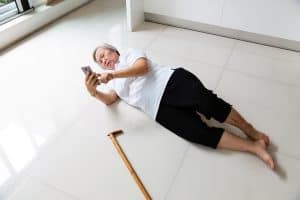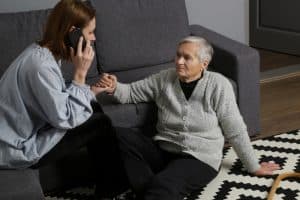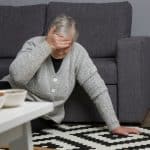
If you fall, the first step is to remain calm. The next step is to determine if you can manage getting up on your own. If you can’t, call for help.
If you have ever fallen before, you already know it is a scary and vulnerable situation to be in. For many older adults, falling can cause serious health consequences, both physically and emotionally. However, feeling prepared with what to do immediately after a fall can help older adults feel empowered and confident should they find themselves on the ground after a slip, trip, or fall.
Senior Falls: A Public Health Concern
While falling is not inevitable as you age, the risk of falling does increase each year. Millions of older adults fall each year. In fact, the Centers for Disease Control and Prevention reports that more than 1 in every 4 seniors over the age of 65 fall each year, though that number is estimated to be low due to older adults not reporting all falls to their loved ones or physicians. For seniors who fall once, the chance to fall again doubles.
Needless to say, older adult falls are a serious public health concern.
About 20% of every senior fall causes serious injuries, like a broken bone or a traumatic brain injury. It is no wonder that about 3 million older adults end up in the emergency room for an injury that results from a fall each year, with about 800,000 of them being admitted to the hospital for further treatment.
But beyond the physical health complications that come from a fall, there are also serious emotional health challenges. For example, many people who fall become terribly afraid of falling again. This can cause them to limit their time out of their favorite chair and ambulate around their home as well as declining social events or taking their usual walk around the neighborhood. Falling quickly leads to sedentary behavior and isolation, which can end up increasing the risk of falling again. It’s a vicious circle that can be difficult to get out of.
Balance and Fall Prevention
The key to safe falling is to prevent falling in the first place. There are certain conditions that can increase the risk to fall, including dementia, Parkinson’s disease and other neurological diseases, vision challenges, and lower body weakness. Having any difficulty with balance or safe walking gait can also drastically increase the risk of falling at home or while out and about.
Good fall prevention protocol includes:
- Speaking with your physician to talk more about your fall risk and to get follow-up recommendations
- Working with a physical therapist and occupational therapist to increase balance and gait safety
- Correctly using any prescribed mobility device, like a cane or walker
- Perform strength and balance exercises daily. If you are unsteady, you can do many exercises from a sturdy chair before graduating to standing up while holding onto a nearby wall for safety
- Working with your optometrist to ensure your eyeglasses prescription is updated
- Creating a safe home environment by increasing lighting, using non-slip surface mats in the bathroom, and installing grab bars as needed
The best place to begin fall prevention strategy is in the physician’s office. Make an appointment and be sure to be candid about your history of falls as well as any fear of falling you might experience.
How to Fall Safely
Even with all the home adjustments and strength training, falls can still happen. Knowing how to fall safely can be crucial to avoiding serious injury. It sounds strange to plan for falling, but if you know what to do in the few seconds that you are falling to the ground, you can take some control back from the situation.
Best practices for falling safely include tips like:
- If possible, angle your body sideways so you fall sideways and not face-first into the ground
- Lean into the fall so you can have some control over where you will land. Try to land in open areas as opposed to areas with tables, chairs, or other clutter
- When possible, keep your head from hitting the ground by protecting it with your shoulder
- Keep your knees bent and try to relax as you fall
- Once you fall, roll to your side in a ball position. This will help to reduce further injury
What to Do If You Fall
If you do find yourself on the ground due to a fall, first do not get up right away. Your adrenaline will be flowing because the situation is scary and while you might feel fine, it is likely that the adrenaline is blocking your ability to feel pain. Instead, stay where you are and get your bearings. Take a deep breath and remain calm.
If you have a device that has fall detection technology, it will likely send a follow-up message or alert to inquire if you are okay. You can determine if you would like to have the device call emergency services or if you can handle the situation on your own.
Now, you can begin to determine if you can get up safely on your own. If at any time you feel pain or lightheaded, carefully lie back down and call for help.
How to Get Up From a Fall
When getting up from a fall, first take a look around you. Ideally, you want to find something sturdy that you can use as leverage. For example, a secured piece of furniture or a staircase might be helpful.
Then, if you aren’t already, roll to your side. It’s smart to roll slowly, starting with your head and shoulders and ending with your hips and leg. You might need to crawl to get to a sturdy surface. If you are unable to crawl to a sturdy surface due to pain, it is time to call for help.
Slide one foot forward as you put both hands on the sturdy surface. Then push up with your foot on the ground to slowly stand up. Sit down for a few moments to re-evaluate how you feel. Remember, you might have felt fine when you tried to get up but you might feel pain now. Determine if you need to call for assistance from a family member, friend, or emergency responders.
Don’t rush the process and if at any time you determine you cannot get up on your own, call for help.
How to Help a Loved One Who Fell

If you notice any confusion, slurred speech, or significant pain in your loved one, call for help.
If you are going to your older loved one’s home and find them on the floor after a fall, it can be startling for you. It can also feel scary and embarrassing for them. Here are a few tips so that you can be as helpful as possible without risking any further injury for them or for yourself.
First, stay calm. If you are panicking, your loved one will begin to panic too. Next, observe for any apparent injury. Look for any blood that could indicate an injury. Then, ask them how they feel while encouraging to remain on the ground where they are. If they are injured, don’t try to move them on your own. Instead, call emergency services to get help.
If it seems they are not injured, you can begin to verbally talk them through rolling onto their side and then crawling to a sturdy surface. You can bring a sturdy surface, like a chair, to them as well. Hold on to the chair to ensure it doesn’t slide while they stand up and sit down on it.
Once your loved one is safely sitting on a chair, observe again for any apparent injuries. Ask them how they are feeling. If they are confused, have slurred speech, or are in pain, call for help.
Who to Call When an Elderly Person Falls
If your older loved one is significantly injured after a fall, dial 9-1-1. When on the phone with them, explain what happened, what injury you can see or any other concern you have, as well as their address. If your loved one is safe sitting on a chair or lying on the ground, after you hang up with 9-1-1, you should unlock the door so first responders can quickly and efficiently come into the home. Stay beside your loved one and wait for first responders to arrive.
If your loved one has a personal emergency response system, you can also push that button to communicate with the monitoring center. Similarly, you will tell them what happened, what you observe, and that you need further assistance.
If your loved one is not injured and does not need any emergency response, you should still inform any family caregivers about the incident as well as your loved one’s physician. It is important to make falls a part of the medical history so that the physician can follow up appropriately.
Normalize Talking About Falls
One of the biggest issues with falling is that it can feel embarrassing or shameful. Many older adults do not report their falls to loved ones or to their medical team because they are worried about what a fall means. They worry that falling means their health is failing, they can no longer be independent, or they are a burden on their families. Most times, a fall does not indicate any of these things.
Do your best to talk more about falls with your older loved one. If they report to you that they did fall, don’t immediately react with anxiety or try to fix it. Instead, ask more questions about how it happened, when it happened, and what they did after the fall. Then, encourage them to talk to their medical team about it just to get it on record so they can work together to create a fall prevention plan moving forward.
After the Fall
If you or your loved one has fallen, the actions you take after the fall are important to recovery as well as to prevent the next one. First, be sure the fall is reported. Next, find out the details of the fall to see if there was an environmental issue that caused it. For example, if there was ice on the front porch, you can fix that by making sure there is a plan in place for someone to put down salt during the next storm.
Next, determine if your loved one could benefit from the peace of mind that comes with having a medical alert device. The right medical alert system can help your loved one feel confident that help is always available in case a fall happens again. This knowledge can decrease the risk of fall anxiety and adopting a more sedentary lifestyle.
Finally, work with a physician and physical therapist to evaluate any prevention strategies. It is wise to begin a strength and endurance program with a physical therapist as well as begin training for any new prescribed mobility device. These sessions with a therapist can be helpful for physical health as well as for mental health, as the person is becoming stronger and more confident in their body’s ability to keep them safe.
Falls are scary and can make older adults feel vulnerable and ashamed. However, the right plan and information can help them feel safe before they fall, during a fall, and after a fall.


